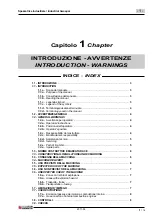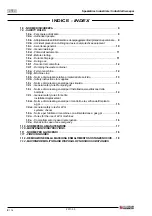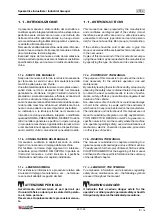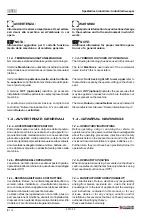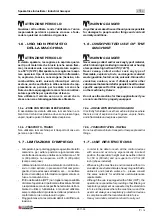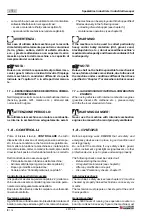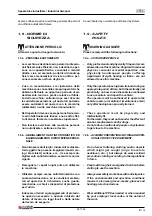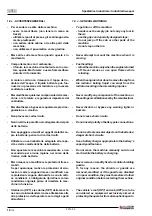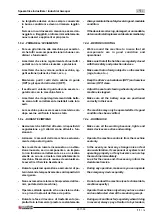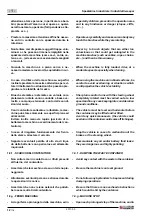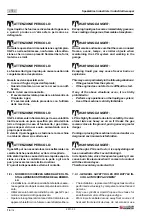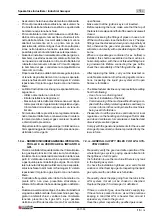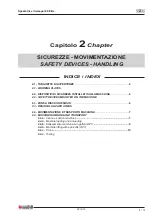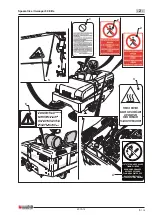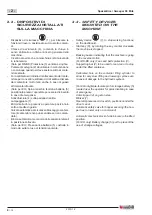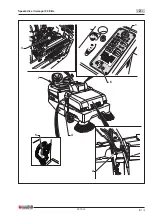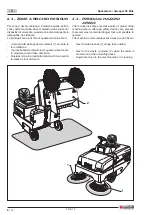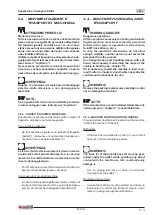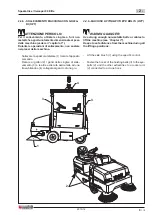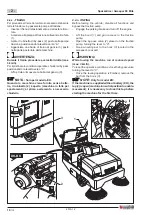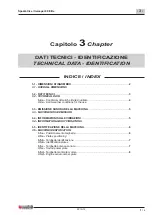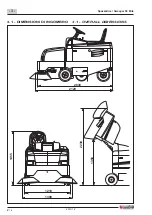
2011-03
15
/
18
- 1 -
Spazzatrice Industriale / Industrial Sweeper
-
Assicurarsi che la chiave di avviamento sia disinserita.
-
Prima di procedere alla sostituzione, assicurarsi che
il rubinetto della bombola da sostituire e quello della
bombola nuova siano ben chiusi.
-
Prima di allentare i raccordi di tubazioni o di tubi fles-
sibili occorre spegnere la macchina e chiudere il rubi-
netto della bombola. I raccordi delle tubazioni vanno
allentati lentamente ed in un primo tempo solo
parzialmemte, altrimenti il gas che si trova sotto pres-
sione nella tubazione fuoriesce violentemente con
possibile pericolo di ustioni da basse temperature.
-
Quando si installa un recipiente amovibile per gas (es.
bombole), questo deve essere montato sulla macchi-
na in posizione orizzontale con il raccordo filettato del
rubinetto orientato verso il basso. Prima di collegare
la bombola del gas, controllare la compatibilità dei
raccordi con il tubo.
-
Dopo la sostituzione della bombola eseguire la prova
di tenuta degli allacciamenti con acqua saponata,
soluzione Nekal o altri mezzi schiumogeni. E’ vietato
ispezionare l’impianto a gas liquido con una fiamma
libera.
-
La Ditta Costruttrice declina ogni responsabilità con-
seguente a:
- Utilizzo di serbatoi non conformi;
- Errata installazione degli stessi;
- Messa in servizio della macchina senza aver rispet-
tato le prescrizioni regolamentari e legislative vigen-
ti in materia di sicurezza nel paese in cui viene uti-
lizzata.
-
Si rimanda a tutte le prescrizioni e regolamenti nazio-
nali o locali sul trattameto e conservazione di conteni-
tori pieni, mobili e chiusi per gas compressi, liquefatti
e disciolti sotto pressione.
Rispettare tutti i requisiti generali per l’utilizzazione e
l’immagazzinaggio dei recipienti sotto pressione pre-
visti dalle norme vigenti.
1.9.m - NORME DI SICUREZZA GENERALI PER IL CON-
TROLLO E LA VERIFICA DELL’IMPIANTO A
GPL
-
Occorre controllare frequentemente che l’intero impian-
to a gas liquido funzioni in modo sicuro, tenendo par-
ticolarmente in considerazione la tenuta di tutte le sue
parti. E’ vietato usare la macchina qualora l’impianto
a gas liquido presenti delle fughe di gas. Per control-
lare la tenuta dell’impianto utilizzare: acqua saponata,
soluzione Nekal o altri mezzi schiumogeni. E’ vietato
ispezionare l’impianto a gas liquido con una fiamma
libera.
-
Controllare frequentemente il tubo tra bombola e im-
pianto GPL; non deve presentare strozzature o
stiramenti. Sostituire il tubo se danneggiato o deforma-
to.
-
Qualora si avverta odore di gas, chiudere il rubinetto di
erogazione della bombola. Se la macchina è parcheg-
giata in ambienti chiusi, ventilare bene l’ambiente
tenendo presente che il gas GPL è piu’ pesante
dell’aria e si diffonde rasente il suolo. Far controllare
open flames.
-
Make sure that the ignition key is not inserted.
-
Before replacing the tank, make sure that the tap of
the tank to be replaced and that of the new tank are well
closed.
-
Before slackening the fittings of pipes or hoses, turn
off the machine and close the bottle’s cock. The pipe
fittings must be slackened slowly and only partially at
first, otherwise the gas under pressure in the pipes
will come out violently, with a possible danger of freeze
burns.
-
When a removable gas container (for ex. bottles) is
installed, this shall be assembled on the machine in
horizontal position, with the cock threaded fitting look-
ing downwards. Before connecting the gas bottle,
check the compatibility of the fitting with the pipe.
-
After replacing the bottle, carry out the leak test on
suds, Nekal solution or other foaming agents connec-
tions. Inspecting the liquid gas system with open
flames is forbidden.
-
The Manufacturer declines any responsibility resulting
from the following:
- Use of a non-conforming tank;
- Incorrect installation of the tank;
- Commissioning of the machine without having com-
plied with the safety-related regulations and law pro-
visions in force in the country where the machine is
being used is forbidden.
-
Please refer to all the provisions and national or local
regulations on the handling and storage of full, mobile
and closed containers for compressed, liquefied and
dissolved pressurized gases.
Comply with the general requirements for the use and
storage of pressurized containers provided for by the
laws in force.
1.9.m - GENERAL SAFETY RULES FOR LPG SYS-
TEM CHECKS
-
Frequently verify the good and safe operation of the
whole liquid gas system, paying special attention to
the tightness of all its parts.
It is forbidden to use the machine if there is any leak
in the liquid gas system.
To check the installation tightness, use: suds, Nekal
solution or other foaming agents. Inspecting the liquid
gas system with open flames is forbidden.
-
Frequently check the pipe going from the tank to the
LPG system; it must not be choked or stretched.
Replace the pipe if it is damaged or deformed.
-
If there is a smell of gas, close the tank’s supply tap.
If the vehicle is parked indoors, air out the premises
keeping in mind that LPG is heavier than air and it
spreads very close to the ground.
Have the system inspected by qualified personnel.

